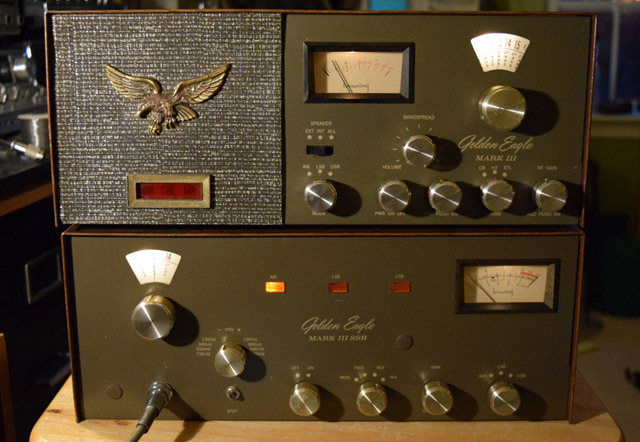

This is the Browning Golden Eagle Mk III. This was the next in a series of high end radios from Browning Labs. First appearing around 1971, the MK III quickly assumed the role of "King of the hill" for those serious hobby users. As can be seen by the picture, this radio was actually housed in two separate pieces. The transmitter and receiver were each housed in its own individual box. This was a tube-type AM/SSB rig, the receiver was adorned with a multitude of user controls, including the standard essentials of Volume, Squelch, a "bandspread" (fine tune or clarifier), mode controls, and a nice large "S" meter. Tuning was accomplished by a continuously variable tuning dial which not only covered the 23 channel CB band, but included an "HF" portion as well, which covered from 27.285, up to 27.595. The transmitter also had a fine tune to track the receiver, and a built-in SWR meter with modulation functionality, as well as illuminated mode indicators. This rig was not cheap, as it cost over $750 in 1970's dollars, which was roughly double what a more modest SSB rig cost then. So consequently, there were not too many of them floating around our more modest neighborhoods.
Having a radio split into 2 separate cases provided some unique operating conditions, which had both good and bad points. It was possible, for instance, to transmit and receive on 2 different channels (and/or modes), in a split form similar to what some hams do. As usual, you can't have a good upside, without a corresponding downside as well. The biggest downside to having separate receiver and transmitter controls occurred when using SSB. Since the transmitter and receiver frequencies were not "locked" together, you more or less had to let other stations tune to you, and then you could tune to them. This was a bit cumbersome for someone who was not comfortable with SSB operation. The plus side though, was that you could adjust your receive for best audio quality without moving the transmitter, which would normally result in a game of "walking the clarifier". Since the receiver was strictly a tunable (although you could install a fixed crystal for your "home" channel), you had no fixed crystal control, and that enabled you to slide through any frequency, including the class "C" channels and the freeband. It was a great radio for sandbagging. But some people preferred the solid control and instant tuning of fixed crystals, especially if you changed channels frequently.
The receiver was well designed and boasted an outstanding 80db advertised adjacent channel rejection, obtained not with the use of mechanical or crystal filters, but with several hi-"Q" tuned IF stages. The transmitter audio was strong and clear, with that warm "tube" sound. But by far the most notorious "feature" of the Golden Eagle was the "ping" which occurred each time the radio was keyed. It was never the same each time, but it immediately identified the radio as a Golden Eagle. Interestingly, this trademark "ping" was actually a design flaw, where the receiver was not completely muted, before the transmitter came up. The "ping" was actually caused by momentary feedback from the receiver, which the operator could hear as well as the people on the channel. But this "defect" actually became a selling point, so the engineers at Browning decided to leave it in. The "ping" became a signature element, something which set this rig apart from the "common" radio. In fact, there were a few companies and individual techies out there, who developed aftermarket add-on devices which attempted to copy this unique ping, but none could duplicate it exactly. The ping could be eliminated though, when it finally started grating on your nerves, or when running late at night, by simply running the squelch up to silence the receiver before keying the transmitter.
There were a few Golden Eagles floating around in my local area, the most notorious being owned by Cap't Coleslaw in the big city. Others included Linda, from Channel 18, and Sneaky Smokey from Channel 5 (hear it in this clip). This was the radio that us young people drooled the most over in the catalogs. But the outrageous cost compared to more "standard" rigs kept most of us from even seeing one in person, let alone owning one at the time. It was the ultimate dream rig. A dream that most of us would never see become reality.
I never had the pleasure of taking command of a MK III back in its heyday, but I did have a MK IV (the 40 channel version) in my possession briefly for repair back in the 90's. I found it to be a "fun" radio for the prestige and reverence that it commanded. But it was not the most friendly radio to run on SSB, and by the time I got a chance to play with it, I already owned a Yaesu FT-757, and the Browning seemed like an old fashioned toy by comparison. Indeed, it would seem that much of this radio's appeal was earned through legend and not through actual hands-on experience. The radio's design, while innovative and cutting edge in the 1960's, was pretty much obsolete by the 1980's. Today, the Golden Eagle is a much sought after collector's item. Recently, I managed to get a good deal on a MK III in need of some TLC. I have since restored it to life and am enjoying the nostalgic status that this rig commands. But it does seem to be better suited for AM operation than SSB.